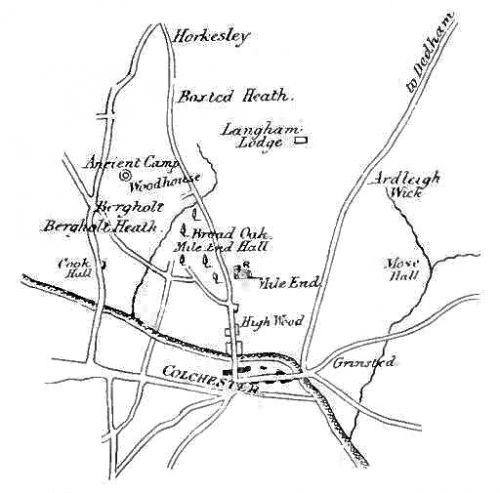Robin Hood's Oak (Horksley Heath)
| Locality | |
|---|---|
| Coordinate | Near 51.925929, 0.878865 |
| Adm. div. | Essex |
| Vicinity | On or near Horksley Heath, c. 4 km N of Colchester |
| Type | Natural feature |
| Interest | Robin Hood name |
| Status | Defunct |
| First Record | 1637 |

By Henrik Thiil Nielsen, 2013-08-07. Revised by Henrik Thiil Nielsen, 2022-05-01.
Robin Hood's Oak once stood on a hill somewhere not very far from the NNW boundary of Colchester, on or near Horksley Heath, "right against Thomas a Bridge, on the left hand of Buttolph's Brook, after crossing the river at Mott's Bridge", localities that are not named on modern maps. It is mentioned in the records of the 1637 and 1671 perambulations in the MS Colchester Assembly Book. The latest local record evidence brought to light so far dates from 1691.
Quotations
Numerous other Oaks remained after the disafforesting of King's Wood; besides the King Oak and the Broad Oak, the Leet Rolls mention Great Oaks in East Street near the Gallows; and in the Perambulation of 1637 (in the Assembly Book for that year, and printed by Morant, p. 95), we have Robin Hood's Oak "right against Thomas a Bridge, on the left hand of Buttolph's Brook, after crossing the river at Mott's Bridge;" and in the Perambulation of 1671 it is added that the Oak stood "right on the pitch of the Hill," and afterwards in the latter Perambulation the Boundary is stated as going" inside the hedge of Soame Wood to Goresbridge, which is at the bottom of 'Beggars Oak' Heath, leading to Ardley Street from Gallow Green.[1]
The isolation of the heath may have encouraged highway robbery; Cut Throats Corner lies on London Road north of Westwood green, and Robin Hood's Oak, which lay next to the main road in 1691, perhaps marked either that or another dangerous spot.[2]
Allusions
1803 - Strutt, Benjamin - History of Colchester
Directions for clockwise perambulation of Liberty of Colchester:] [...] down Shett's hill to Newbridge, and then into the fields formerly held by Matthew Ayleward, through a gate a little above the bridge: And so along to the yard formerly of the said Matthew Aylward; cross the river into a meadow folrmerly of the said Matthew Ayleward, and cross that meadow into the lower part of West-fields, near to which is a foot bridge, laid cross the river, called Mott's bridge. And so along through West fields to a gate in a lane at or near the north end of a meadow formerly held by one Samuel Duglet, which lane parts West-fields from Bergholt. And from thence to Buttolph's brook, along the course of which proceed, always [p. 150] leaving the brook upon the left hand, to a bridge, called Thomas Abridge, leading on to Horkesley heath; which bridge is right against the pitch of the hill where an oak called Robin Hood's oak anciently stood. From thence proceed along the road which leads to Nayland, over Horkesley heath to Black brook under Chesterwell; which brook runs across the road at the foot of Horkesley causeway.[3]
Gazetteers
- Not included in Dobson, R. B., ed.; Taylor, J., ed. Rymes of Robyn Hood: an Introduction to the English Outlaw (London, 1976), pp. 293-311.
Sources
- Essex Record Office D/DGw M34, rot. 26. Not seen
- Hidden East Anglia - Gospel Oaks & Other Notable Trees, referring to British History Online (accessed 2013.05.24).
Discussion
- British History Online: Great Horkesley; web edition of: 'Great Horkesley: Introduction', in: A History of the County of Essex, vol. 10: Lexden Hundred (Part) including Dedham, Earls Colne and Wivenhoe (2001), pp. 219-223.
- Harrod, Henry. Report on the Records of the Borough of Colchester (Colchester, 1865), p. 26.
- Shenstone, J.C. "The Oak Tree in Essex", The Essex Naturalist: Being the Journal of the Essex Field Club, vol. VIII (1894), pp. 89-117, see p. 114; paraphrases Harrod.
Also see
Notes
- ↑ Harrod, Henry. Report on the Records of the Borough of Colchester (Colchester, 1865), p. 26.
- ↑ British History Online: Great Horkesley, referring to Essex Record Office D/DGw M34, rot. 26.
- ↑ Strutt, Benjamin. The History and Description of Colchester, (the Camoludunum of the Britans, and the First Roman Colony in Britain,) with an Account of the Antiquities of that Most Ancient Borough (Colchester, 1803), pp. 149-50.
